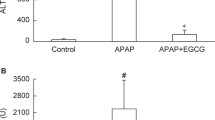Abstract.
The coffee components kahweol and cafestol (K/C) have been reported to protect the colon and other organs of the rat against the formation of DNA adducts by 2-amino-1-methyl-6-phenylimidazo[4,5-b]pyridine (PhIP) and aflatoxin B1. PhIP is a cooked-food mutagen to which significant human exposure and a role in colon cancer etiology are attributed, and, interestingly, such cancers appear to develop at a lower rate in consumers of coffees with high amounts of K/C. Earlier studies in rodent liver have shown that a key role in the chemopreventive effect of K/C is likely to be due to the potential of these compounds to induce the detoxification of xenobiotics by glutathione transferase (GST) and to enhance the synthesis of the corresponding co-factor glutathione. However, mutagens like PhIP may also be detoxified by UDP-glucuronosyl transferase (UDPGT) for which data are lacking regarding a potential effect of K/C. Therefore, in the present study, we investigated the effect of K/C on UDPGT and, concomitantly, we studied overall GST and the pattern of individual GST classes, particularly GST-θ, which was not included in earlier experiments. In addition, we analyzed the organ-dependence of these potentially chemopreventive effects. K/C was fed to male F344 rats at 0.122% in the chow for 10 days. Enzyme activities in liver, kidney, lung, colon, salivary gland, pancreas, testis, heart and spleen were quantified using five characteristic substrates and the hepatic protein pattern of GST classes α, µ, and π was studied with affinity chromatography/HPLC. Our study showed that K/C is not only capable of increasing overall GST and GST classes α, µ, and π but also of enhancing UDGPT and GST-θ. All investigated K/C effects were strongest in liver and kidney, and some response was seen in lung and colon but none in the other organs. In summary, our results show that K/C treatment leads to a wide spectrum of increases in phase II detoxification enzymes. Notably, these effects occurred preferentially in the well perfused organs liver and kidney, which may thus not only contribute to local protection but also to anti-carcinogenesis in distant, less stimulated organs such as the colon.
Similar content being viewed by others
Author information
Authors and Affiliations
Additional information
Electronic Publication
Rights and permissions
About this article
Cite this article
Huber, W.W., Prustomersky, S., Delbanco, E. et al. Enhancement of the chemoprotective enzymes glucuronosyl transferase and glutathione transferase in specific organs of the rat by the coffee components kahweol and cafestol. Arch Toxicol 76, 209–217 (2002). https://doi.org/10.1007/s00204-002-0322-1
Received:
Accepted:
Issue Date:
DOI: https://doi.org/10.1007/s00204-002-0322-1




